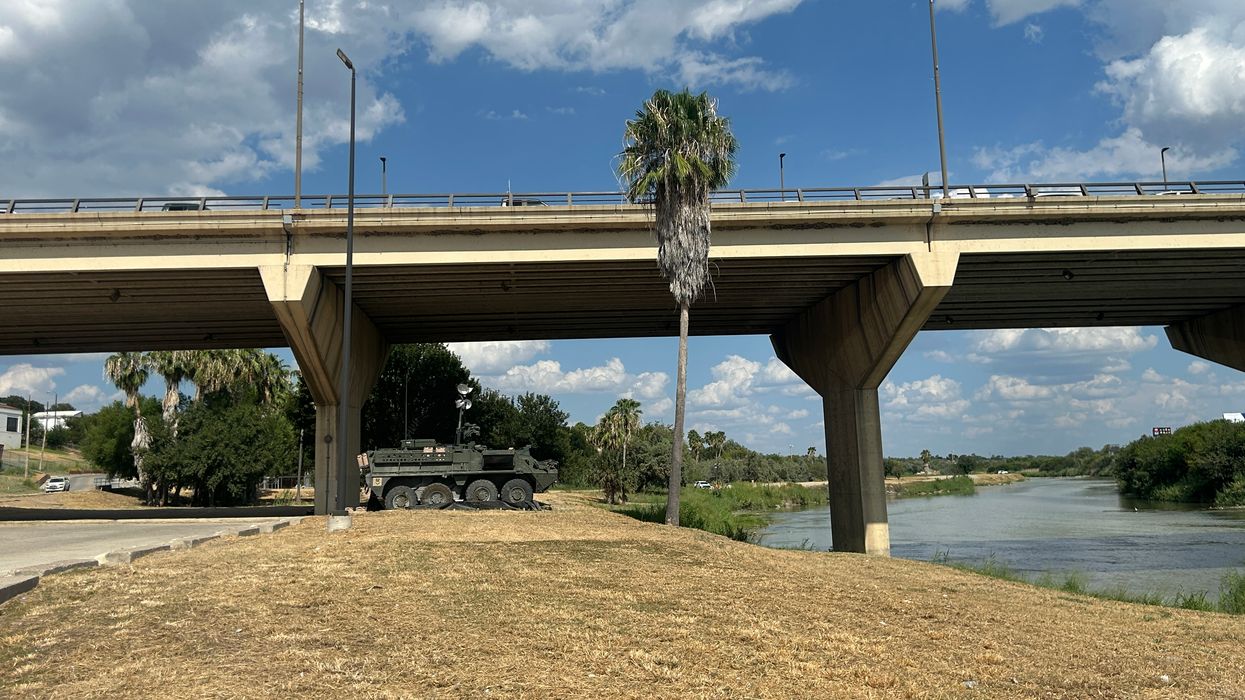LAREDO, Texas — The Trump administration has deployed military Strykers to the southwest border, ramping up immigration enforcement in ways unseen during the Biden administration and more visible to local communities.
In Laredo, Texas, one Army Stryker – an eight-wheeled armored vehicle used in military operations – is stationed in front of the Rio Grande River, a stone’s throw from Mexico and steps from a city park. It’s parked underneath the pedestrian bridge that connects Laredo to its sister city, Nuevo Laredo, Mexico.
President Donald Trump has increased military presence in non-border cities as well, deploying the National Guard to Los Angeles in response to anti-ICE protests and to Washington, D.C., to combat crime.
Trump has argued that tackling illegal immigration will also reduce crime committed by undocumented immigrants.
Changes at the border
Border enforcement in the Laredo sector looks different today than it did just a few years ago, according to Border Patrol Chief of the Laredo Sector Jesse Muñoz, who says stricter enforcement policies and advanced technology have reshaped operations.
Apprehension numbers are historically low, averaging just 20–25 per day, compared to thousands in past years.
Muñoz, who began his career as a Border Patrol agent in Laredo in 2006, described the changes as transformative. “It’s really kind of changed border enforcement, how we operate,” he said.
At any given moment, Border Patrol cars patrol city roads and station themselves along the river, where city parks are also located. Although Laredo residents are all too familiar with seeing Border Patrol vehicles, some say they’ve noticed an increased presence.
“You notice that there's a lot more Border Patrol in town,” said business owner Janet Zapata.
Border Patrol falls under the Department of Homeland Security, a federal agency, and is not a military branch. However, the all-hands-on-deck approach, coordinated among Border Patrol, the Laredo Police Department, the Webb County Sheriff’s Department, the military, and other local law enforcement agencies, has positioned the city to become one of the safest in the U.S.
“Their presence here is obvious, given an enforcement aspect that we've really haven't seen,” said Public Information Officer Joe Baeza with the Laredo Police Department.
The location of the military vehicle is steps from the Tres Laredos city park and near an outlet mall, uniquely reflecting a dichotomy between two worlds – residents living their daily lives as immigration agents circle around.
"It's normal to see Border Patrol to me. My mom lives about a block away from the river, by Laredo South, and we hear Border Patrol all the time, and it's just part of life," said local journalist Alex Cano. "That's what you see. You see a possible chase. You just make sure you move to the side. But you know that it has nothing to do with you."
LPD does not directly handle immigration enforcement, but officers may encounter a situation that requires collaboration with Border Patrol, like a traffic stop involving an undocumented immigrant ending in a high-speed chase or busting a stash house.
Stash houses are where human smugglers hold migrants, often in overcrowded and unsanitary conditions for days or weeks. LPD has received fewer reports of stash houses.
“It’s probably because of the substantial drop in the number of people coming here,” Baeza said.
Things have looked different at the border, but “safe” is how locals characterized Laredo; the city’s annual homicide rates often don’t surpass double digits. Overall, life in Laredo, as residents described, is community- and family-oriented, frequently misjudged by outsiders looking in.
“Every city does have danger, but just because we're living on the border doesn’t mean it’s actually dangerous,” Zapata said.
Immigration can be portrayed as a crisis and chaos, but Laredoans say life is more about community than conflict.
But does militarization improve public safety?
The arrival of military surveillance vehicles at the river raised concerns among some residents. Muñoz dismissed the idea of militarization, insisting the assets are strictly supportive.
“There is no militarization at the border. They’re here to help with border security,” he told The Fulcrum. “They don’t do any military operations. They’re 100% in a support role.”
The Center for Civilians in Conflict, an organization that advocates against governmental policies that it deems harmful to civilians, defines militarization as the influence of equipment, tactics, and mindset on domestic law enforcement. This includes the transfer of military equipment and the regular flow of personnel to local law enforcement agencies.
Police militarization “is where the police and military intersect in weaponry, funding, and tactics, according to another organization, War Resisters League.
The Laredo Police Department said it does not work directly with either the military or Border Patrol.
However, public interest and debate over what’s visible spark the question of whether the Trump administration’s policies and actions are effective for public safety.
The military has traditionally been called upon to respond to civil disorder, not crime, according to Ronald Spector, a George Washington University professor emeritus of history and international relations and a Marine veteran.
“I don’t think there are many instances where in the past where the National Guard was called up specifically to reduce crime,” Spector told The Fulcrum. “The National Guard and the militia before that were conceived as forces that would be called up in case of civil disorders, such as strikes or riots.”
On the border, one of the largest interventions occurred in 1916, when President Woodrow Wilson sent the U.S. Army into Mexico after Pancho Villa raided Columbus, New Mexico.
“It was a complete failure… they never captured Pancho,“ Spector said. “Very shortly after the Marines arrived [in Latin America], they realized that they needed police. They weren’t optimum for preventing crime and chasing bandits.”
Ashley N. Soriano is a graduate student at Northwestern University Medill School of Journalism in the Politics, Policy, and Foreign Affairs specialization.
The Fulcrum is committed to nurturing the next generation of journalists. To learn about the many NextGen initiatives we are leading, click HERE.




















